10 Tricks Fake Fitness Coaches Use on Instagram (and How to Spot Them)
- GrumpyJogger

- Sep 18
- 6 min read
The fitness industry has a problem, and it’s not carbs, or cardio, or whether you should be squatting with your toes at 30° or 35°. The problem is smoke and mirrors.
Lately, Instagram has been swarming with so-called “high-ticket” coaches. You’ve probably seen them: polished profiles, flashy payment screenshots, dramatic before/after photos, and vague testimonials about clients who supposedly lost 15kg in 12 weeks or paid $20,000 upfront for online coaching.
Sounds too good to be true? That’s because it usually is.
And this matters. Because people, often overwhelmed and vulnerable, are getting pulled in. Recently, these coaches have been zeroing in on a very specific group: tired, overweight, menopausal women. Why? Because they’re busy, have disposable income, and don’t always have time to check credentials. They trust, and they get taken advantage of.
Here’s how the game works.
How Coaches Fake Authority on Instagram
Trick 1: Fake Authority

Coaches buy followers to make their Instagram look impressive. Suddenly, they’ve got 20k followers but only a handful of likes and comments. Engagement doesn’t match? Doesn’t matter; the big number is enough to fool people into thinking they’re important. Ah, and let's not forget the blue mark! That tiny, but coveted symbol that is supposed to mean something. We got used to thinking "blue mark = legitimate person", but now anyone can purchase it... Slap a "specialist" or "expert" next to it, and voilà!
Trick 2: Fake Engagement
If they commit and want to splurge a bit more, they will also buy their followers' reactions. Those “🔥🔥” or “Love this!” comments? Often, bots or engagement pods, not real fans.
Trick 3: The Illusion of Success
This is where the Stripe screenshots and cherry-picked testimonials roll in. You’ll see recycled lines like “I made $10k in my first month!” or “client paid me $20k upfront.” But context is everything.
A single prepayment doesn’t equal monthly recurring income. ($100k prepaid = just over $8k/month spread across the year.)
One cropped WhatsApp message is not proof of a thriving business.
Also, sometimes, those screenshots don’t come from clients at all.
Trick 4: Scarcity Games & Pushy Sales
The weekly “Only 3 spots left!” or “I’m full” announcements pushing you to buy today. Yet somehow, there are always three spots left. (?) Scarcity sells, even when it’s fake.
Trick 5: Before & After Tricks
Lighting, posing, clothes, and even same-day “slouch vs. flex” tricks can create a dramatic “transformation.” Sometimes the photos aren’t clients at all. They’re friends, stock images, paid actors, or even the trainer himself/herself! (Hello, Photoshop and new photo editing phone apps!)
Before & after photos I added from free stock images. It took me less than a minute!
Trick 6: Inflated Credentials
Logos slapped on profiles with vague “certified coach” claims, but no clear mention of who certified them, or when. Sometimes they don't even bother to fake that part...Hoping that their story will win them clients anyway.
Trick 7: The High-Ticket Funnel
Here’s the real playbook:
Pick a big emotional problem (usually women’s weight loss).
Post about pain → solution → “DM me READY.”
Funnel people into a call.
Run a scripted “strategy session” that ends in a $2k–$5k coaching offer (sometimes even $20k).
Use Stripe screenshots or before/after photos as proof that it works.
Repeat.
And the delivery? Usually, copy-paste PDFs, generic macros, and a few check-ins. No personalisation. No accountability. No real coaching.
Trick 8: The “My Story” Trick
This one’s everywhere: “I used to be overweight, I lost 20kg, and now I can show you how to do it too.”
Look, I’ve had back problems, gut issues, and skin flare-ups. That pushed me to spend 15+ years studying, earning credentials, and becoming a Pilates instructor and health coach. Personal struggles can absolutely shape what we teach.
But here’s the catch: a personal story isn’t a qualification. What worked for this "coach" might be completely wrong, or even harmful, for someone else. Especially if someone is, let's say, a young guy trying to coach menopausal women about hormones!
Experience is valuable. But without proper knowledge and context, it’s not coaching, it’s just selling a story.
Trick 9: The “Specialist Overnight” aka "My Niche"

High-ticket playbooks often tell coaches to “niche down.” Sounds harmless, right? Until suddenly, someone with zero formal training declares themselves an expert in women’s hormones, PCOS, scoliosis, or weight loss for diabetics. Real specialisation requires years of study, certifications, and ongoing education. But in this game, it’s not about accuracy; it’s about picking a marketable niche and slapping “specialist” on your bio.
Trick 10: Reels & Visibility - Using Social Media to Build Their "Credentials"
Social media rewards the loudest voices, not the most qualified ones, as I said once before. Someone with zero credentials can start recording themselves doing workouts, flexing a six-pack or tiny waist, showing their own weight loss progress, and suddenly they’re everywhere. More visibility = more clients. Meanwhile, trainers who actually want to train people don’t have the time or patience to chase likes and views. We’d rather spend our energy reading, studying, building programs, or actually coaching clients, not performing for an algorithm.
The Numbers Don’t Add Up
Here’s a question nobody seems to ask: If a coach is making $50k, $100k, or more every month… And if they have so many before/after photos of tons of clients... How many clients do they actually have?
Unless they’re a celebrity trainer charging $1,000+ an hour, that means dozens (if not hundreds) of clients at once. And as someone who’s been coaching for 15 years, let me tell you: coaching can be draining. Real coaching requires energy, attention, and personalisation. I used to have 20-30 clients at once. And I just never want to do it again...
If someone’s churning through lots of clients at “high-ticket” rates, the quality of coaching will inevitably suffer. It’s simple math. And human limits. My personal ceiling is 10 clients at any given time. Anything more than that - no thank you. Why? Imagine having to take care of 10 kids on top of your own family. (Yeah, sorry, but you are kind of like my kids...😅)
My coaching, although focused on core and gut health, involves a lot of aspects that start from your daily life and habits, and end with actual food and training. So managing 10 lives and making sure it's healthy, safe and effective? Not easy. Not if you want to provide high-quality care and long-lasting results.
Why Knowing How to Spot Fake Fitness Coaches Matters
The issue isn’t just wasted money. (Although that is very important too!) It’s the long-term damage. Best-case scenario? People get burned once and then lose trust in the entire industry. Even when they genuinely need help, they’re reluctant to reach out again, because all coaches look like scammers after an experience like that. Worst-case? People get injured or damage their health, which can be irreversible in some cases.

Meanwhile, the good coaches, the ones who’ve studied, who truly care, who adapt to each client, get drowned out by the noise...
How to Protect Yourself
If you’re considering a coach, ask:
What certifications do you hold, from where, and when?
Can you share case studies with timelines and measurable results?
What’s your refund or guarantee policy?
Do you have a website or registered business details?
Can I contact past clients for references?
If they dodge, give vague answers, or guilt-trip you? 🚩 Red flag.
What Real Coaching Looks Like
Don’t be blinded by big numbers or flashy transformations. Instead, look for a coach who:
Explains how they’ll help, not just the end result.
Listens to your goals, limitations, and lifestyle instead of shoving you into a template.
Obvious, but not so obvious - has the necessary credentials & experience.
Real coaching isn’t about hype. It’s about sustainable change, trust, and long-term results.
The Bigger Picture
This isn’t about envy or gatekeeping. It’s about protecting people from smoke-and-mirror tactics that exploit trust. Real coaching is built on experience, credentials, and client success, not on Stripe screenshots and before/after photos. (I have been in this industry for 15 years and never posted such photos. Wonder why...? I simply don't need it, and I protect my clients' privacy.)
So next time you see a coach bragging about a "$100k month"? Take it with a shaker full of salt. While they’re playing at quick wins, some of us are focused on building sustainable, credible businesses that last and help people be healthy for the rest of their lives, not just 12 months during the generic coaching program.
I’m writing this because I care about the industry, and I care about people not getting scammed. If you’ve been burned before, know this: it’s not your fault. The system is set up to look legit when it’s not. And the more we call it out, the more space we make for coaching that actually transforms lives. The right way.
I’m sharing a few examples of trainers’ Instagram accounts to illustrate the tricks we’ve talked about. (Random accounts that came my way. I blurred their names to respect privacy, and also to avoid providing free advertising 😜)
I’m not saying these people aren’t qualified. But take a moment to ask yourself: where are the credentials? Where’s the website? Where’s any verifiable information about them besides reels, flashy posts, and carefully curated content created by… well, themselves?
It’s an important reminder: visibility doesn’t equal expertise. Always look deeper than what’s on the screen.











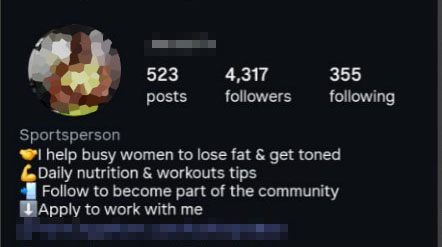

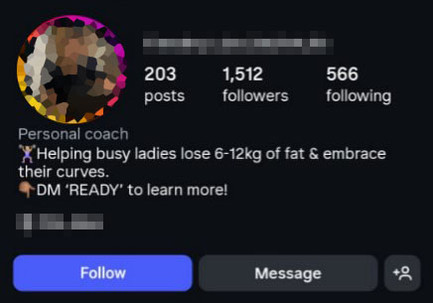

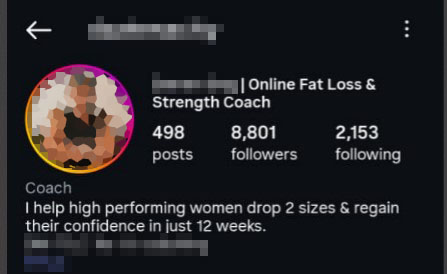

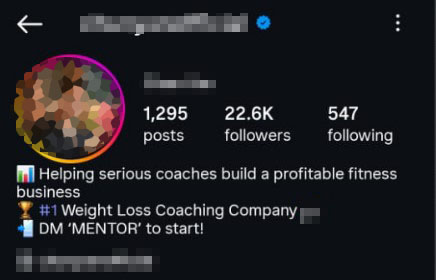

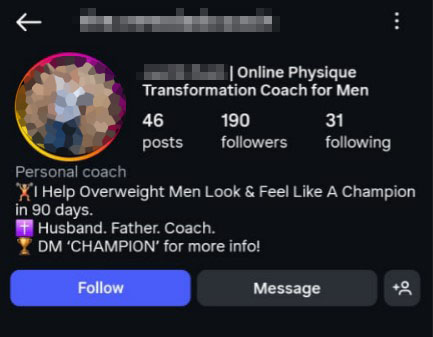





Comments